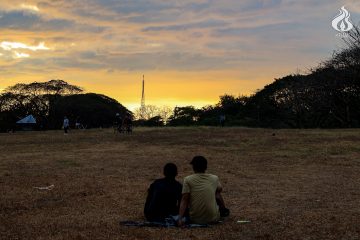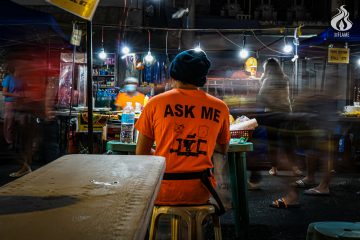IN THE spirit of celebrating Filipino film excellence, the Puregold CinePanalo Film Festival is screening from March 15 to 26 at Gateway Cineplex 18. It offers six full-length films and 25 student-produced short films. This year’s festival categorized the short films in five sets.
UST communication senior Dizelle Masilungan’s film, Kung Nag-aatubili, and five short films were included in the Shorts D cluster.
Kung Nag-aatubili reaped four plums in the awarding ceremony. Masilungan was named the best director and was among the recipients of the Mowelfund Film Institute Scholarship grant, which offers filmmaking workshops. Communication senior Anton Acosta bagged the best cinematography award, while Aishkylos Akiyama garnered the best supporting actor award. The film also placed third in the Movie and Television Review and Classification Board’s “Responsableng Paglikha ng Pelikula” award.

Kung Nag-aatubili
Gelo (David King Escio), a struggling art student trying to find his muse for his thesis, meets the enthusiastic Kael (Akiyama) on the hill one afternoon. Gelo tries to find inspiration from the scenery. His solitude is interrupted when Kael claims the hill, frightening him away.
The sappy encounter between the two was the start of their relationship — Gelo is aloof, and Kael is a mystery, yet both feel a void in their lives. They try to inspire each other by being each other’s muses.
Kung Nag-aatubili’s cinematography was well-executed and used to the advantage of the storyline’s progress. With its scenic view of the hill, it followed the film’s central theme of presenting artistry through the two main character’s surroundings.
The color grading made the surroundings more appealing. The pastel colors of the afternoon sky highlighted Gelo and Kael’s relationship — innocent and serene, yet a bit restrained, with their meetings only during sundown.
The visual composition of the film was put together well. The depth of the field was presented through a wide shot angle to depict the fever dream-like moments of Gelo and Kael together in the landscape, with tall trees towering over them.
In the montage scene at the end, the arrangement of the shots combined with Acosta’s musical scoring produced a serene film that portrayed how one’s nuances in life could be approached more slowly without pressure.
The camera panning was sensibly used to establish the character’s dependence on objects, which makes his personality. For instance, when Gelo realizes that his sketchbook is missing, the camera double-panned on him and exhibits his room on a high angle with artwork scattered throughout as he tries to find his missing sketchbook, allowing the viewers to see through Gelo’s character.
To further establish the queer theme of the film, the one-liner responses of Gelo should have been improved as their relationship furthers, as it feels to be one-sided until the end because of his short responses to Kael.
The acting of the two main actors was commendable as they embodied the characters as themselves. Although Escio’s character had few lines, his demeanor, and his eyes did the speaking. Meanwhile, Akiyama made up for the silence of Escio’s character with his giddy character.
However, Kael was not heavily explored as a character. A switch of emotions with his character was very few and limited. Despite being lively, his character felt monotonous by only showcasing one emotion. The only time Gelo lost his composure was when he complimented Gelo’s features under his breath. His background as a local, too, was not introduced in the film, nor to Gelo.
The climax of the film was vague. From exposition to resolution, the peak of the film was not distinguished from the first and the last part. Original and creative dialogues between the two characters would promise a better screenplay if the connection were built before the film’s resolution. It directly proceeded with the montage of their musings in the end. The slice-of-life theme overshadowed the lack of pinnacle of the relationship between the two characters.
Masilungan’s film narrates how not all queer love needs to be excessive and extreme, which puts the characters at risk. The film exhibited a distinct relationship that does not necessarily equate to hardship.
He delivered a film about love without the constraints of prejudice, a pure tenderness between two people who found their way during the exact time when the two characters needed each other’s company the most.
Masilungan’s idea of presenting a film about boys’ love was not entirely targeted due to the film revolving around the production of good cinematography. The aesthetics of the film were prioritized, and the diegesis was left behind. Some of the lines worked well with the theme of a slice of life, yet it did not add depth to the film’s message. The screenplay failed to convey something new about living a serene life and the difficulties that accompany such a life.
The other four films of Puregold Cinepanalo’s Shorts D showcased the winning stories in life from different people of different backgrounds.

Remedy Soup (Tambal nga Sabaw)
John Wilbert Llever Sucaldito’s film explores the diaspora in the Philippines and how it eventually affects family dynamics. There was tension between the two brothers, who struggled to fend for themselves. They are not used to their mother’s absence, who left for work overseas.
The pent-up rage of the older brother led to an argument, which escalated quickly as his younger brother faced his wrath. Later on, the two reconciled through a shared meal, a staple in their family.
The transition of conversation between the two brothers felt genuine. However, the mother’s acting was not expressive with her delivery of lines. The cinematic focus of the film emphasized the setting, which is the family’s kitchen table. During dialogues, the divide between the two brothers was magnified through the rule of thirds.
Layag sa Pangarap
Andrea Ponce directed the second film in the set. The film follows the main character Sean as he struggles to fulfill his lifelong dream of expressing his real self, while also trying to carry out the wish of his father for him to be a marine. Layag sa Pangarap exhibits the struggles of a child who tries to keep up with his family’s expectations.
However, the film’s cinematography and storyline are lacking. The film also needs improvement because the location looks limited, and the props do not follow the plot. Some of the actors’ lines were also stiff and unnatural.
Sa Hindi Paghahangad
Neil Espino’s film follows two characters in their journey to finding themselves as the pressure of a successful future is expected in their years of adulthood as college students. They embark on the journey while showcasing their relationship as friends and trying to overcome the difficult journey of trying to figure out what the future awaits.
The film was difficult to follow because of its unclear central theme and lengthy dialogues between the characters, which were unnecessary for the film’s progress. The acting felt unnatural due to the screenplay’s formation of the character’s personality.

Text FIND DAD and Send to 2366
The last entry on the set was a film by Kent Michael Cadungog about a rich girl who pretends to be poor in an attempt to find her dad. The main character is instructed by a voice on how to act in a reality show to convince the viewers about her background as a poor teenage girl. The storyline of the film is comedic in an abstract way.
The film was intentionally humorous, yet it felt natural because of the characters’ line delivery and performance. The short form was used to its advantage because the ending left an enigmatic impact on the audience, which added to the film’s appeal and separated it from other films in the set.
All of the films in Short D contributed a fresh outlook on life to local cinema. Although there is still room for improvement, especially in using the technical aspects of creating the films to their best performance, each film was still able to differentiate itself from the rest with its unique outlook on life.
Above all, it is best to remember that a film’s screenplay is just as important as the visual composition. Aesthetics should not outweigh the plot, nor should the plot outweigh the visual appeal. F — Hjadoeya Calica



